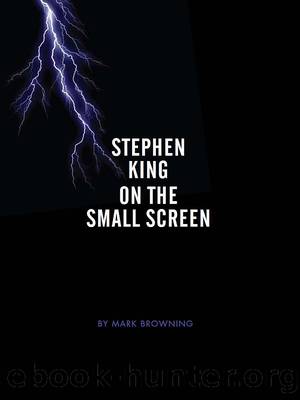Stephen King on the Small Screen by Browning Mark;

Author:Browning, Mark;
Language: eng
Format: epub
Publisher: Intellect Books
Published: 2011-08-15T00:00:00+00:00
A human drama?
You scare people badly enough, you can get them to do anything.
(David in The Mist)
Part of its televisual aesthetic is also related to its static nature. The limited location and tendency to talk in the first half of the film at least rather than action, as well as the cast largely drawn from experienced TV performers, feels closer to armchair theatre. There is an element of low-budget limitation in the setting - for the most part, the filmâs action is entirely set in the store and even the supposed nearby pharmacy could be filmed anywhere as the mist prevents wide or establishing shots. Darabont does well to insist from the outset of the store element of the plot that there are many people in the building and we see in high angle 20-30 individuals looking out and to be fair, he is overtly concerned less with dwelling on the source of the monsters than with the human dynamic that develops in response to them. However, ambiguities about causes raise questions about their effects. The narrative does dramatize the circumstances in which religious bigotry can flourish but the disproportionate space given to Carmody makes her character more tiresome than persuasive. The speed with which she whips up and radicalizes the group in the store stretches credibility to breaking point. As Amanda notes, âItâs not even two daysâ. Even before Carmody is established as an extreme presence in the narrative, an emotional appeal by a mother (Melissa McBride) for someone to accompany her is far too overwrought and sounds an oddly melodramatic note out of synch with the emotion of the scene.
Norton places his faith in rationality but also has his fair share of petty grudges towards his fellow townsfolk who he feels are out to humiliate him. The exact back-story of a property dispute with David is only really lightly touched upon but there is the sense of existing divisions between regular citizens and so-called âout-of-townersâ such that it does not take much for petty resentments and jealousies to rise to the surface. However, none of these are either particularly interesting or spelled out in clear detail. Amandaâs branding as a âwhoreâ by Carmody (which does not really work with the sexual episode removed), the alcoholism of Jim Grondin (William Sadler), or Carmodyâs reputation as unstable, are all presented as givens. We see the attempt by David to persuade Norton from a distance, without dialogue, as from the point of view of a minor onlooker, representing also Darabontâs approximation of Kingâs shift to reported speech.16
The dominant style adopted by Darabont is resolutely concerned with the small rather than the big screen and in a search for a slightly more documentary style, he discussed camera technique with the crew of The Shield (Shawn Ryan, FX Networks, 2002-08). In a limited range of locations, especially once in the store, the camera movement is restless, often via handheld shots and dominated by positioning that is obscured or often rotates around characters and focus that is suddenly pulled for little apparent reason.
Download
This site does not store any files on its server. We only index and link to content provided by other sites. Please contact the content providers to delete copyright contents if any and email us, we'll remove relevant links or contents immediately.
| Direction & Production | Genres |
| Guides & Reviews | History & Criticism |
| Reference | Screenwriting |
| Shows |
Head of Drama by Sydney Newman(2025)
Robin by Dave Itzkoff(2010)
I'm Judging You by Luvvie Ajayi(1893)
The Paranormal 13 (13 free books featuring witches, vampires, werewolves, mermaids, psychics, Loki, time travel and more!) by unknow(1850)
Single State of Mind by Andi Dorfman(1515)
Ten by Gretchen McNeil(1501)
#MurderTrending by Gretchen McNeil(1397)
Key to the Sacred Pattern: The Untold Story of Rennes-le-Chateau by Henry Lincoln(1352)
Most Talkative by Andy Cohen(1311)
Merv by Merv Griffin(1268)
This Is Just My Face by Gabourey Sidibe(1181)
Notes from the Upside Down by Guy Adams(1180)
Jamie Oliver by Stafford Hildred(1148)
The Hunger Games: Official Illustrated Movie Companion by Egan Kate(1121)
Springfield Confidential by Mike Reiss(1107)
Clarkson--Look Who's Back by Gwen Russell(1079)
The TV Writer's Workbook: A Creative Approach To Television Scripts by Ellen Sandler(1072)
Blue Planet II by James Honeyborne & Mark Brownlow(1022)
Dark Angel by D. A. Stern(1015)
